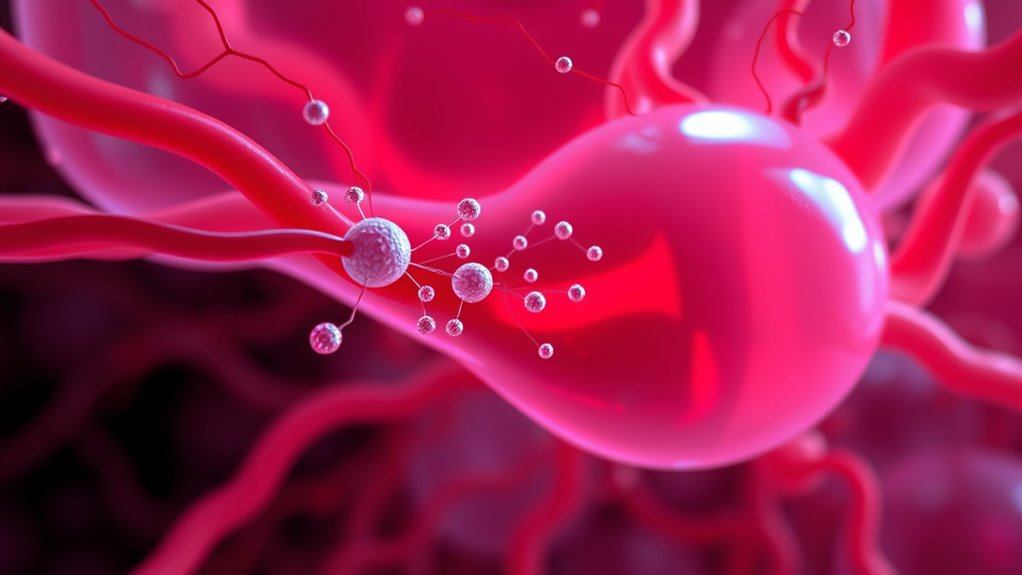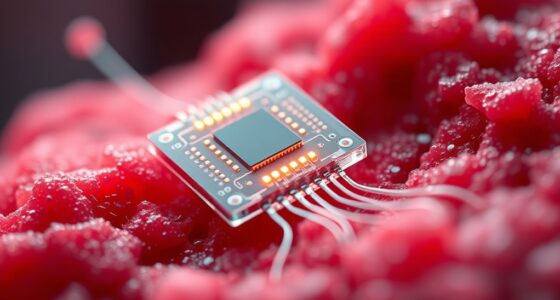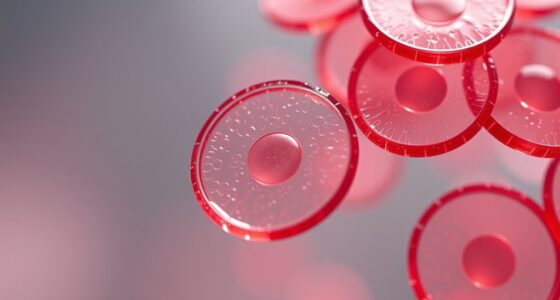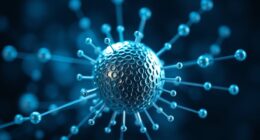Nanomachines in neuroscience are designed to cross the blood-brain barrier by mimicking natural transport methods, such as targeting specific receptors like transferrin or insulin. They use receptor-mediated endocytosis or transcytosis to enter the brain, often enhanced with surface functionalizations. Advances include stimuli-responsive features and biomimetic coatings, allowing targeted drug delivery, diagnostics, or neural repair. Continuing to explore these innovations reveals how these tiny machines could transform brain healthcare.
Key Takeaways
- Nanomachines utilize receptor-mediated endocytosis and transcytosis to traverse the blood-brain barrier efficiently.
- Surface functionalization with targeting ligands enhances nanomachine specificity for BBB crossing.
- Stimuli-responsive nanomachines enable controlled, localized drug release within the brain.
- Advances include biomimetic coatings and external stimuli (magnetic, ultrasound) to improve delivery and immune evasion.
- Overcoming BBB challenges with nanomachines promises improved treatments for neurodegenerative diseases and brain disorders.
Understanding the Blood-Brain Barrier and Its Role in Brain Health
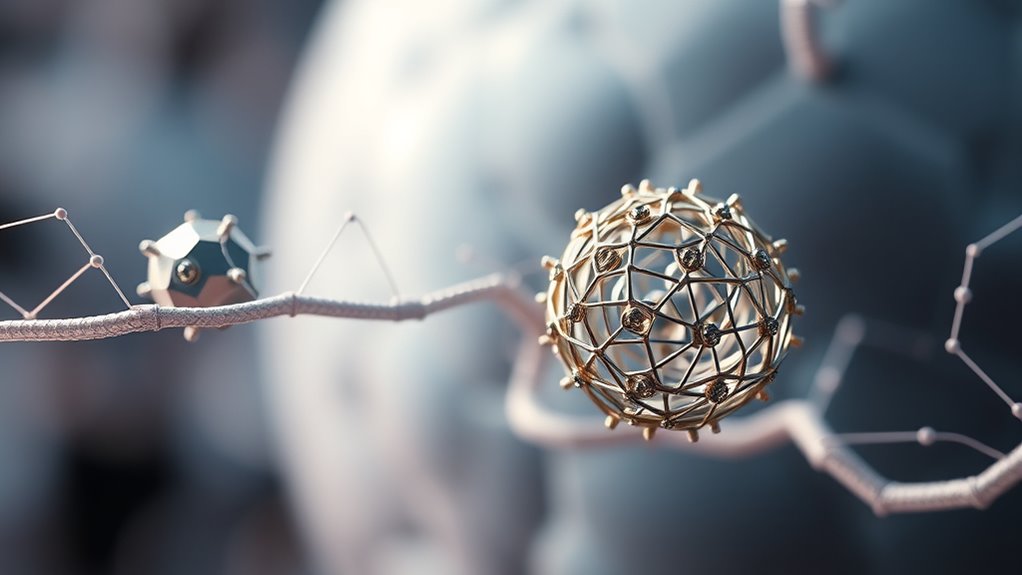
Have you ever wondered how your brain stays protected from harmful substances while still receiving essential nutrients? It’s thanks to the blood-brain barrier (BBB), a specialized network of tightly packed cells lining your brain’s blood vessels. This barrier acts like a vigilant gatekeeper, allowing vital nutrients like glucose and oxygen to pass through while blocking toxins, pathogens, and chemicals. The BBB’s selective nature maintains a stable environment, essential for proper brain function. Tiny molecules and certain gases can slip through easily, but larger or harmful substances are kept out. This protection is indispensable, preventing infections and damage. However, it also makes delivering medications challenging, which is why understanding the BBB’s role in brain health is so important for developing new therapies. Understanding the blood-brain barrier’s function is crucial for advancing targeted drug delivery to treat neurological disorders effectively.
The Challenges of Delivering Therapeutics Across the BBB
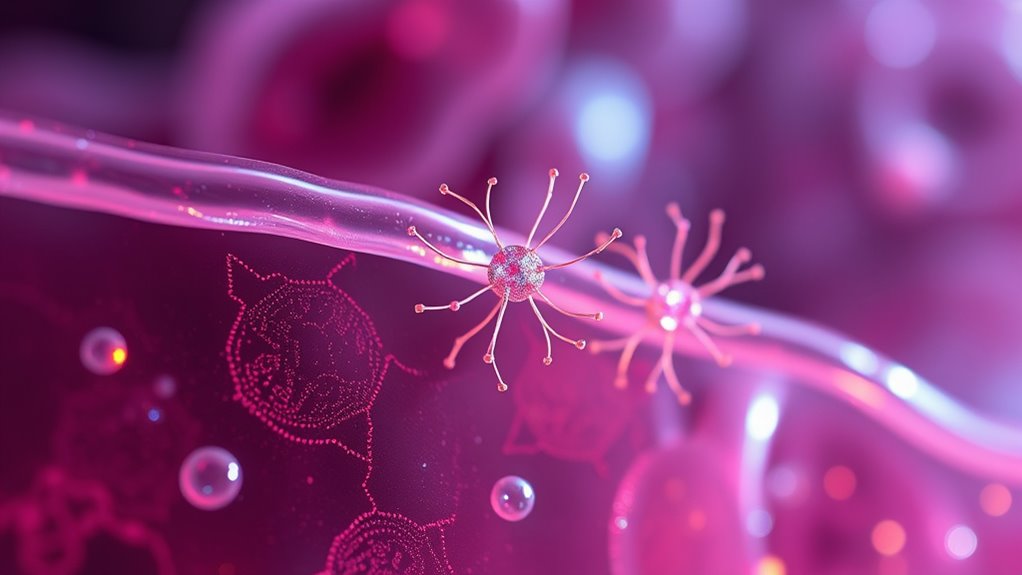
Delivering therapeutics across the BBB is challenging because membrane permeability barriers block many drugs from reaching the brain. You need targeted delivery strategies to bypass or cross these barriers effectively. However, nanocarrier stability issues can hinder the safe and efficient transport of treatments into neural tissue. Incorporating high-performance nanomaterials can enhance nanocarrier stability and improve delivery efficiency.
Membrane Permeability Barriers
The blood-brain barrier (BBB) presents a formidable obstacle to the effective delivery of therapeutics to the brain. Its membrane permeability barriers tightly control what crosses into neural tissue. You face challenges like:
- Tight junctions between endothelial cells that restrict paracellular transport
- Efflux pumps actively removing foreign substances, reducing drug retention
- Lipid composition of cell membranes that limit the passive diffusion of many drugs
These barriers prevent many therapeutic agents from reaching their targets. You need to contemplate innovative strategies to bypass or transiently open these membranes without causing damage. Understanding these permeability mechanisms is vital for developing effective nanomachines capable of crossing the BBB safely and efficiently. Overcoming these barriers involves a delicate balance between permeability and maintaining brain protection. Additionally, AI-driven safety measures can support the development of targeted delivery systems by predicting potential risks and optimizing therapeutic strategies.
Targeted Delivery Strategies
How can therapeutic agents effectively cross the blood-brain barrier to reach their targets? You can use targeted delivery strategies that exploit specific transport mechanisms or receptor-mediated pathways. Nanomachines are engineered to recognize and bind to receptors on the BBB, triggering endocytosis and transcytosis. Ligand-conjugated nanoparticles, for instance, can ferry drugs directly to brain tissues while minimizing systemic exposure. You might also employ temporary BBB disruption methods, like focused ultrasound, to enhance permeability selectively. These approaches aim to improve delivery efficiency, reduce side effects, and ensure that therapeutics reach precise neural targets. Developing such strategies requires understanding BBB biology and designing nanodevices that navigate this complex barrier effectively.
Nanocarrier Stability Issues
Nanocarriers face significant stability challenges when crossing the blood-brain barrier, which can compromise their ability to deliver therapeutic agents effectively. They are prone to degradation by enzymes in the bloodstream, leading to premature release or loss of payload. Additionally, nanocarriers can aggregate or fuse, reducing their ability to navigate narrow capillaries and target tissues precisely. External factors like pH fluctuations and shear stress from blood flow further threaten their integrity. To overcome these issues, you can employ strategies such as:
- Surface modifications to enhance resistance against enzymatic breakdown
- Incorporating protective coatings to prevent aggregation
- Designing stimuli-responsive systems to maintain stability until reaching target sites
Addressing these stability issues is vital for ensuring efficient and safe delivery of nanomedicines across the BBB. Holistic approach considers multiple factors influencing nanocarrier performance and can help develop more robust delivery systems.
How Nanomachines Are Designed to Traverse the BBB
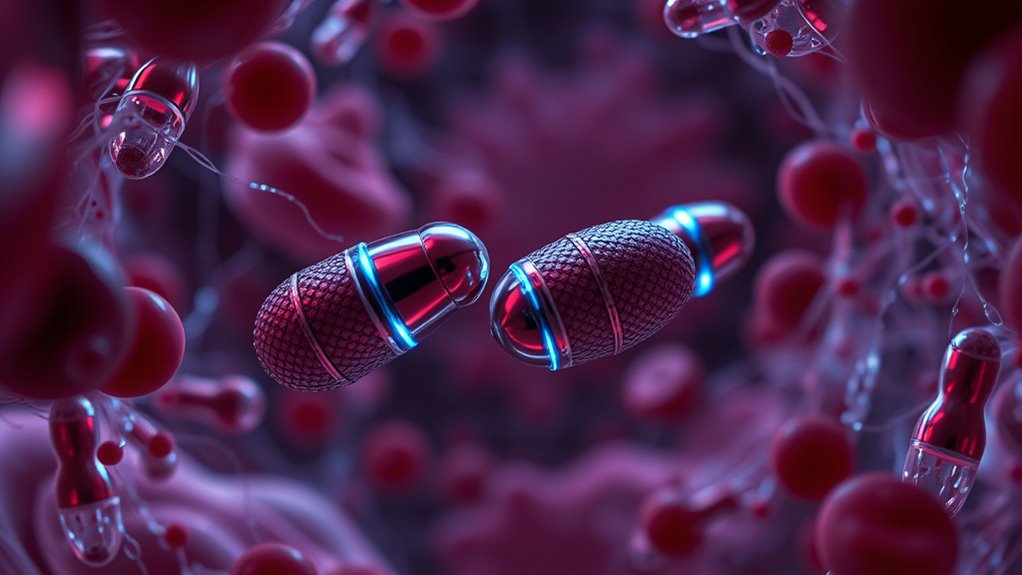
Designing nanomachines to cross the blood-brain barrier (BBB) requires a strategic approach that leverages specific surface modifications and targeting mechanisms. You tailor their surfaces with ligands or peptides that recognize and bind to receptors on BBB cells, effectively tricking the barrier into allowing entry. This precision minimizes damage and maximizes delivery efficiency. To evoke emotion and illustrate potential, consider this table:
| Strategy | Impact |
|---|---|
| Surface ligand functionalization | Enables targeted crossing |
| Receptor-mediated targeting | Facilitates safe, efficient entry |
| Nanomachine size optimization | Ensures permeability without damage |
| Biocompatible coatings | Prevents immune rejection |
| Stimuli-responsive features | Releases cargo precisely inside brain |
This careful design ensures your nanomachines don’t just pass through—they succeed in reaching their destination. Additionally, understanding the blood-brain barrier’s unique properties is crucial for developing effective nanomachines capable of crossing it safely.
Mechanisms of Nanomachine Transport and Entry Into the Brain
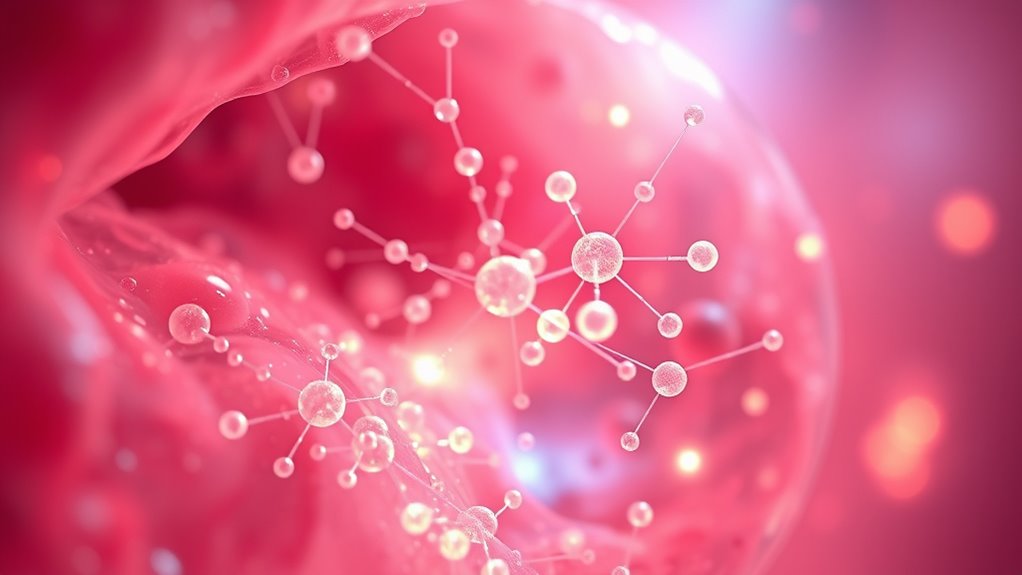
You can leverage transcytosis pathways to help nanomachines cross the blood-brain barrier efficiently. Receptor-mediated entry mechanisms allow these devices to target specific cells, increasing their precision. Understanding these processes is key to optimizing nanomachine delivery into the brain. Additionally, knowledge of advanced materials can help improve the strength and functionality of nanomachines, making them more effective in navigating biological barriers.
Transcytosis Pathways Explored
To effectively deliver nanomachines into the brain, understanding transcytosis pathways is essential, as these mechanisms enable nanomaterials to cross the blood-brain barrier (BBB). Transcytosis involves transporting nanomachines through endothelial cells via vesicular processes. Researchers explore various pathways, including adsorptive-mediated transcytosis, which relies on charge interactions, and macropinocytosis, a nonspecific engulfment process. Clathrin- and caveolae-mediated transcytosis are also studied, involving specialized vesicle formations. These pathways can be influenced by nanomachine surface properties, such as size, shape, and surface chemistry. By manipulating these features, you can optimize nanomachine transport, improve crossing efficiency, and minimize potential damage or immune responses. Understanding these mechanisms helps develop more effective, targeted delivery systems for brain therapeutics.
Receptor-Mediated Entry Mechanisms
Receptor-mediated entry mechanisms offer a highly targeted approach for transporting nanomachines across the blood-brain barrier. You can design nanomachines to bind specific receptors on endothelial cells, such as transferrin or insulin receptors. When these receptors recognize and attach to your nanomachine, they trigger endocytosis, pulling the nanomachines into the brain tissue. This method guarantees precise delivery, minimizing off-target effects. To optimize this process, you adjust the surface chemistry of your nanomachines, attaching ligands that mimic natural receptor ligands. This strategy enhances receptor affinity and uptake efficiency. Receptor-mediated entry is a promising avenue for delivering drugs, genetic material, or diagnostic tools deep into the brain with high specificity and reduced systemic exposure. Additionally, understanding how attention can be cultivated during the design process may improve the precision and effectiveness of your nanomachines.
Current Advances and Experimental Approaches in Nanomachine Research
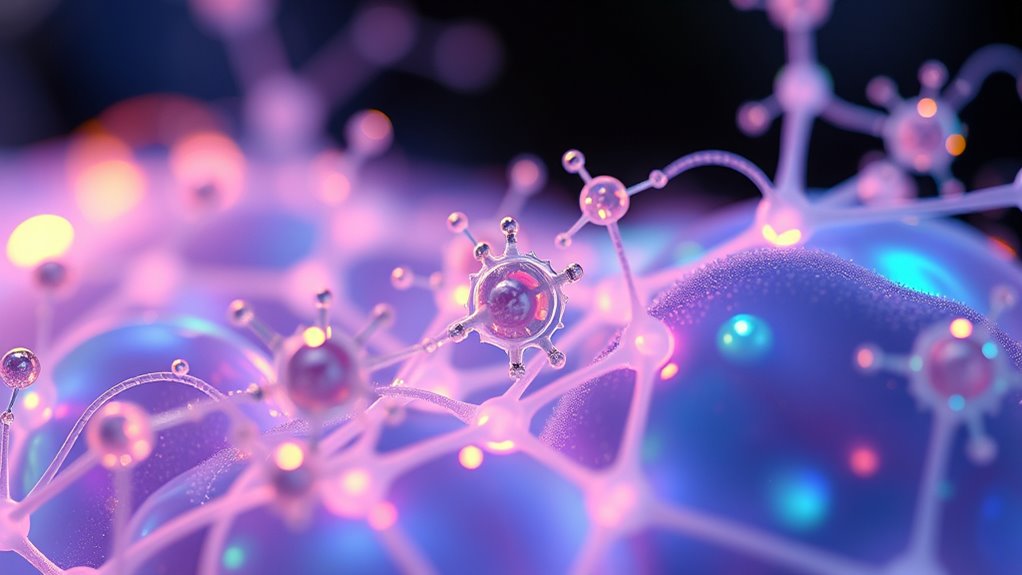
Recent advancements in nanomachine research have markedly accelerated our understanding of their potential in neuroscience. Researchers are developing innovative techniques to design and optimize nanomachines capable of crossing biological barriers and targeting specific neural structures. Experimental approaches include engineering surface modifications to improve biocompatibility, utilizing advanced imaging to track nanomachine movement, and employing stimuli-responsive materials for controlled activation. These methods help refine delivery efficiency and minimize off-target effects. You should also consider home decor – inspired strategies like using biomimetic coatings to enhance immune evasion, incorporating nanoscale sensors for real-time monitoring, and applying external stimuli, like magnetic or ultrasound, for precise control. These approaches are paving the way for more effective, targeted interventions, bringing us closer to practical applications in neuroscience.
Potential Applications for Diagnosis, Treatment, and Neural Repair
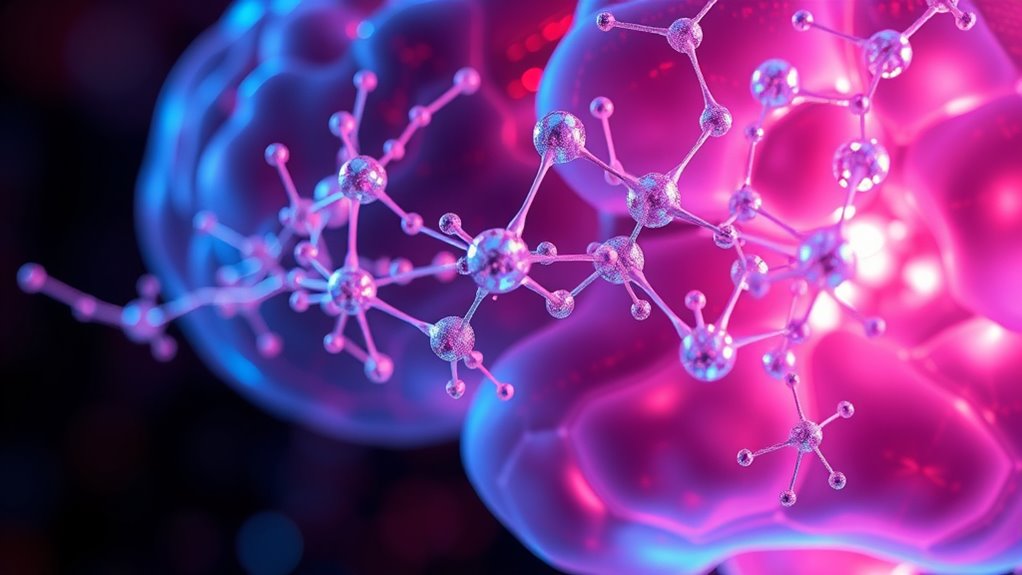
Advances in nanomachine technology are opening new possibilities for diagnosing, treating, and repairing neural conditions. You can now imagine nanomachines that target specific brain regions to detect early signs of neurodegenerative diseases, providing real-time data with high precision. For treatment, nanomachines can deliver drugs directly to affected neurons, reducing side effects and increasing efficacy. They can also clear protein aggregates linked to conditions like Alzheimer’s or Parkinson’s. In neural repair, nanomachines may help regenerate damaged tissues by promoting cell growth or removing scar tissue. This targeted approach minimizes invasiveness and enhances recovery outcomes. As these technologies evolve, you’ll see a shift toward personalized medicine, where nanomachines customize interventions based on individual neural profiles, revolutionizing how we diagnose and treat neurological disorders. Additionally, ongoing research into best anime movies and animated films that touch hearts highlights the importance of innovative storytelling and emotional connection in advancing understanding and engagement in science and medicine.
Future Perspectives and Ethical Considerations in Nanomedicine
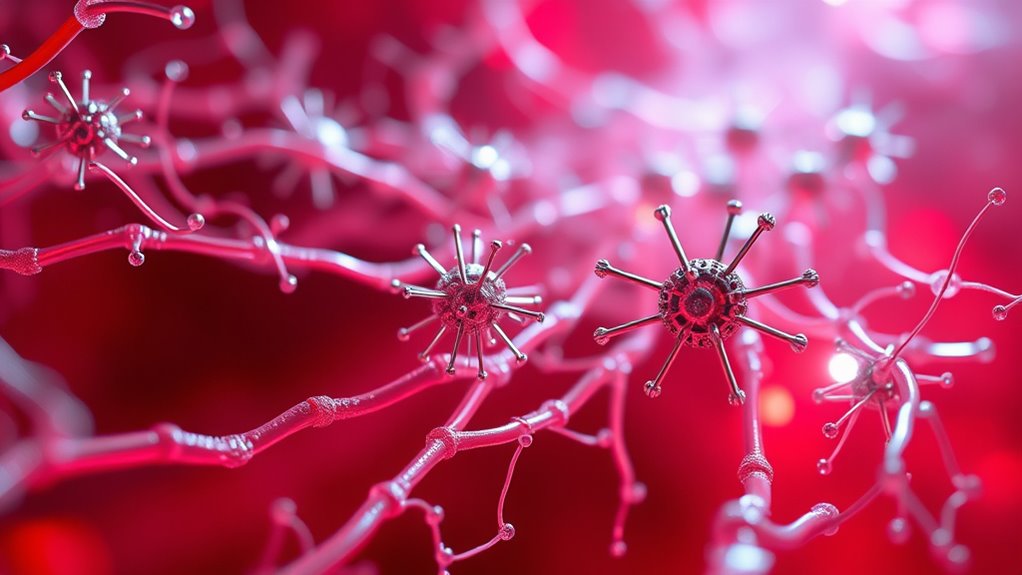
As nanomedicine continues to evolve, its future holds remarkable potential for transforming neural healthcare, but it also raises significant ethical questions that require careful consideration. You must consider issues like patient safety, informed consent, and long-term effects. The rapid advancement of nanomachines prompts debates about privacy, as these technologies could monitor or influence brain activity. Additionally, equitable access becomes a concern, ensuring that breakthroughs benefit all rather than a select few. Developing comprehensive privacy policies and ethical guidelines is crucial to address these challenges and maintain public trust.
- Ensuring transparency in research and applications
- Addressing potential misuse or manipulation of neural data
- Establishing regulations to prevent unintended consequences
Balancing innovation with responsibility is essential. As you explore these frontiers, you’ll need to navigate ethical boundaries thoughtfully, fostering trust, safety, and fairness in the future of nanomedicine.
Frequently Asked Questions
How Do Nanomachines Target Specific Brain Regions?
You can make nanomachines target specific brain regions by functionalizing their surfaces with molecules that bind to unique markers or receptors found only in those areas. When injected, these nanomachines navigate through the bloodstream and recognize their target via these molecular signals. This precise targeting guarantees they deliver drugs or perform actions exactly where needed, minimizing side effects and increasing treatment effectiveness.
What Are Potential Long-Term Effects of Nanomachine Use in the Brain?
You might experience long-term effects like immune responses, inflammation, or unintended tissue damage if nanomachine use persists. There’s also a risk of cumulative toxicity or interference with normal brain functions over time. While ongoing research aims to minimize these risks, it’s important to stay cautious and monitor for any adverse effects, as the long-term safety of nanomachines in the brain isn’t fully understood yet.
Can Nanomachines Be Used to Treat Neurodegenerative Diseases?
Absolutely, nanomachines can treat neurodegenerative diseases. Imagine precisely targeting affected brain cells, delivering drugs exactly where needed, reducing side effects. You might see them repair damaged neurons or clear harmful proteins linked to conditions like Alzheimer’s or Parkinson’s. Their ability to cross the blood-brain barrier open up new possibilities, turning complex treatments into more effective, minimally invasive therapies. This innovation could revolutionize how you manage and potentially cure these debilitating diseases.
How Are Nanomachines Powered Inside the Brain Environment?
You’re likely curious about how nanomachines get their power inside the brain. They typically harness energy from the brain’s own environment, like glucose or other molecules, through tiny fuel cells or catalytic reactions. Some designs use external energy sources, such as magnetic or electromagnetic fields, to activate or power them remotely. This method guarantees they operate efficiently without damaging surrounding tissue, enabling precise medical interventions.
What Regulations Govern the Development of Nanomachine-Based Therapies?
You should know that developing nanomachine-based therapies is governed by strict regulations from agencies like the FDA and EMA. They require thorough testing for safety, efficacy, and ethical considerations before approval. You’ll need to follow guidelines on clinical trials, manufacturing standards, and potential risks. Staying updated on evolving regulations guarantees your research complies and helps you bring innovative, safe treatments to patients responsibly.
Conclusion
You now see how nanomachines could revolutionize brain health, crossing the blood-brain barrier with precision. Did you know that over 95% of potential neurotherapeutics never reach their target due to this barrier? With ongoing advancements, you could soon benefit from targeted treatments and neural repair techniques that were once impossible. Embracing these innovations might just unleash a new era in neuroscience, offering hope for millions worldwide.
